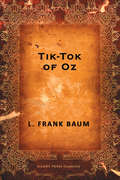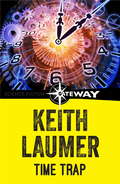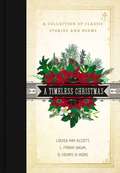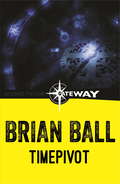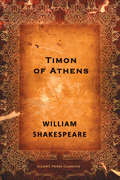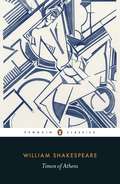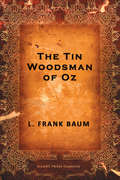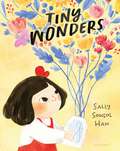- Table View
- List View
Through the Looking-Glass
by Lewis CarrollThis 1872 sequel to Lewis Carroll's beloved Alice's Adventures in Wonderland finds the inquisitive heroine in a fantastic land where everything is reversed. Looking-glass land, a topsy-turvy world lurking just behind the mirror over Alice's mantel, is a fantastic realm of live chessmen, madcap kings and queens, strange mythological creatures, talking flowers and puddings, and rude insects.
Los tigres de Mompracém
by Emilio SalgariEL primer relato de Salgari apareció por entregas en 1883 en el periódico milanés "La valigia", y en septiembre del mismo año la ''Nuova arena" publicó, también por entregas, su primera novela, Tay-See. Un año más tarde, con la aparición, siempre por entregas en la "Nuova arena", de La tigre della Malesia (que más tarde se publicaría en libro con el título Los Tigres de Mompracem, 1911) obtuvo de repente el éxito, que indujo en un segundo momento a Salgari a iniciar la carrera de escritor independiente, trasladándose con su numerosa familia a Turin, donde esperaba establecer más fácilmente los contactos editoriales. Fue el periodo de las mejores pruebas de su inmensa producción literaria, de las novelas todavía legibles no tanto por la exótica y colorista ambientación y originalidad de los contendidos, sino, sobre todo, por la rapidez de la acción y el corte casi cinematográfico de las peripecias y por la viva humanidad de los protagonistas, paladines de una raza especial: Sandokán, llamado el Tigre de Malasia, su amigo Yanez, los célebres corsarios, personajes agitados por fuertes pasiones e inclinados a la violencia, pero transformados por la inagotable vena fantástica del escritor en héroes legendarios del ideal y de la justicia.
Tik-Tok of Oz (The Land of Oz #8)
by L. Frank BaumThe eighth book in L. Frank Baum's beloved Oz series, Tik-Tok of Oz finds a the young Betsy Bobbin and her trusty mule, Hank, magically transported from Oklahoma to the same fantastical world once visited by Dorothy Gale. In Oz, Betsy befriends the kindly, old Shaggy Man, and agrees to help him search for his missing brother in the Nome Kingdom. Joined by the mechanical man, Tik-Tok, and a cast of colorful characters, Betsy and Shaggy Man soon find themselves dealing with a much bigger problem: trying to prevent a war between the greedy Queen of Oogaboo and the wicked King of the Nomes, which threatens all of Oz.
The Time Machine
by H. G. WellsOne of the greatest science fiction writers of all time paints a vivid and terrifying picture of humanity's possible future. An unnamed inventor tests his latest creation - a time machine. It works, pulling him far into the future, but while exploring this new world the time machine is stolen, forcing the Time Traveller to rely on help from the innocent, idyllic Eloi to recover it from the brutal, subterranean Morlocks. The book touches on socio-political issues such as classism and industrialization. It has been adapted for film twice. Penguin Random House Canada is proud to bring you classic works of literature in e-book form, with the highest quality production values. Find more today and rediscover books you never knew you loved.
The Time Machine
by H. G. WellsHG Wells science fiction fantasy, The Time Machine challenges the reader's mind to the possibility of time travel.
Time Trap (Time Trap)
by Keith LaumerABE LINCOLN IN AFRICA?He was seen - and photographed - in a Tunisian bazaar. And an ancient Spanish galleon, fully crewed with ancient Spaniard, was taken in tow off Tampa by the Coast Guard...and a few luckless people found themselves living the same day over and over and over...Something was badly wrong with Time - but Roger Tyson didn't know it until he met the lovely agent from elsewhen and started on a mad chase through the dimensions, plagued by a motley bunch of temporal castaways, and pursued hotly by Oob the Rhox!
A Timeless Christmas: A Collection of Classic Stories and Poems
by Louisa May Alcott L. Frank Baum O. HenryDelight in the most wonderful time of the year with a collection of heartwarming and heartfelt Christmas classics. From O. Henry’s iconic story “The Gift of the Magi” to L. Frank Baum’s quaint and clever history of Santa Claus and his reindeer, the pieces gathered in A Timeless Christmas honor the yuletide tales and traditions passed down through generations. The beloved stories, poems, and reflections in this collection have been carefully curated to bring cheer and merriment to readers who appreciate the simple gifts of hope and peace. Christina Rossetti’s beautiful poetry, L. M. Montgomery’s charming short stories, and many other classic works will bring warmth to the fireside this season and remind us all that Christmas is a time for joy. With additional pieces from Louisa May Alcott, George MacDonald, and more, A Timeless Christmas will become a cherished keepsake for friends and family to enjoy this year and for years to come.
Timepivot
by Brian BallTime drifted onto the ruin of the Galactic Federation. The centuries rolled over the wars of the first part of the new millennium, laying their patina of forgetfulness over the adventures of the survivors of the expedition to the Forever Planet. Only in the memory banks of lost and ruined computers was there a record of the withering piece of time, hung in its weird universe, poised in a matrix of forever, which had waited eons to release its makers from their imprisonment on a planet which was their plaything, workshop, laboratory and engine. No one returned to the planet of the Timepivot. Not of his own volition.
Timon of Athens
by William ShakespeareWhen he loses his fortune, and he is forced to seek assistance from those he has helped in the past, Timon on Athens quickly learns who is friends are.`
Timon of Athens: A Tragedy - Primary Source Edition (Mobi Classics Series)
by William Shakespeare Nicholas WaltonAfter squandering his wealth with prodigal generosity, a rich Athenian gentleman finds himself deep in debt. Unshaken by the prospect of bankruptcy, he is certain that the friends he has helped so often will come to his aid. But when they learn his wealth is gone, he quickly finds that their promises fall away to nothing in this tragic exploration of power, greed, and loyalty betrayed.
The Tin Woodsman of Oz (The Land of Oz #12)
by L. Frank BaumIn the twelfth Oz story, the Tin Woodman and the Scarecrow meet Woot, a Gillikin boy.<P><P> The Woodman tells him how the Wicked Witch of the East (punishing him for falling in love with her ward, Nimmie Amee) enchanted his axe, which then compelled him to chop off every part of his body. The tinsmith Ku-Klip replaced them with body parts fashioned from tin. Lacking a heart, the Woodman left her. In The Wonderful Wizard of Oz, Dorothy and the Scarecrow found him in the woods; when they reached the Emerald City, the Wizard gave him a new heart. Encouraged by Woot and accompanied by him, the Scarecrow and Polychrome, the Rainbow's daughter, the Woodman travels to the Munchkin Country to look for her. Many adventures follow, although their quest is ultimately unsuccessful, as Nimmie is now married to Ku-Klip's assistant, Chopfyt.
Tiny Wonders
by Sally Soweol HanThe world is full of wonders, if we take a small moment to look! A beautiful story about everyday magic.April's town is dull and gray, and the people there are too busy to laugh or look up at the sky. But when April remembers Grandma's stories about wonder in the world, like the secret language of flowers, April wonders: Can dandelions help? Planting tiny seeds while the seasons shift towards spring, April watches as the dandelions and other flowers sprout, bringing more than a little wonder back to her community.Debut author-illustrator Sally Soweol Han's gorgeous and inspirational story encourages young readers to consider how they too can plant a little wonder in the world.
Tirso de Molina: Don Gil of the Green Breeches (Aris & Phillips Hispanic Classics)
Tirso de Molina enjoys enduring popularity as a writer of irreverent comedies, though his critical reputation as a major dramatist rests largely on his more serious works. Don Gil of the Green Breeches as befits a high farce is much concerned with disguise, mistaken identity, role-reversal, ghosts, and trousers! Dona Juana, jilted by her lover Don Martin, follows him to Madrid, where, under the assumed name of Don Gil, he is courting the wealthy Dona Ines. Dressed as a man in a distinctive pair of green breeches, Dona Juana also masquerades as Don Gil. Don Martin is outwitted by his transvestite rival, who wrecks his schemes like a maleficent will-'o-the-wisp before leading him, shell-shocked, to the altar! In his lively, accurate and fluent line-by-line verse translation of this play Gordon Minter admirably conveys the unique flavour of Tirso's sparkling wit. Additionally, in his stimulating Introduction and Commentary he argues that this effervescent drama deliberately subverts the Don Juan legend to show that the Trickster of Seville's female counterpart can be just as resourceful and predatory when the restoration of her honour is at stake. The further revelation that Don of the Green Breeches has unobtrusively and unnoticed contributed an important strand to subsequent European versions of the Don Juan legend completes a scholarly reappraisal of the significance of a work too often regarded as little more than a highly amusing dramatic confection.
Tirso de Molina: Jealous of Herself (Aris & Phillips Hispanic Classics)
Tirso de Molina's Jealous of Herself (c. 1622-23) is an ingenious comedy of disguise and deception, set in the streets, plazas and fashionable apartments of early 17th-century Madrid. Nearly forgotten for almost 400 years, the play is starting to gain attention today for its very modern perspective on male desire and the difficult situation placed on women who must live up to an ideal fantasy projected onto them. Much like another product of early 17th-century Spain, Miguel de Cervantes's world-famous novel Don Quixote , Jealous of Herself follows a lofty-minded man who worships an idealised image of a woman. It then shows us a world that gets turned upside down when other characters end up playing into this fantasy. Unlike Don Quixote, however, Jealous of Herself shifts its attention from the dreamer to the dreamed that is, to the individual trapped in and torn apart by this fantasy, the young woman, Dona Magdalena. Her internal conflict, the fact that she finds herself jealous of herself, ultimately becomes the axis of the play. Jealous of Herself is also a lively, wonderful piece of theatre. Written by a highly inventive playwright at a time when the Spanish theatre was at its peak, it has fascinating lead characters, verbal dexterity, rapid-fire wit and a strong sense of mood and place. Carefully structured, it builds relentlessly, climaxing with two great set-piece scenes that deserve to be on any list of great Renaissance-era stage moments. Until now, the play, whose Spanish title is La celosa de si misma , has been unavailable to English-language readers and audiences. This book is the first-ever English translation.
Tirso de Molina: Tamar's Revenge (Aris & Phillips Hispanic Classics)
The story comes from the Second Book of Samuel and tells of the incestuous passion of Amnon, David's eldest son, for his half-sister, Tamar and the subsequent murder of Amnon by his brother Absolom. Amnon's lust is set in the context of complementary passions of ambition and revenge, reflected in Absolom and Tamar respectively. The play explores King David's conflict between justice and mercy when confronted with these tragic events. It is a work of constantly changing perspectives in which tragedy and comedy, instead of being simply juxtaposed, are blended in a highly original way. Tirso's play is one of the earliest treatments of a theme that has continued to be an inspiration for such modern writers as the novelist Dan Jacobson in The Rape of Tamar and the dramatist Peter Shaffer in Jonadab . Spanish text with facing-page translation, commentary and notes.
Tirso de Molina: The Trickster of Seville and the Stone Guest (Aris & Phillips Hispanic Classics)
Tirso de Molina was, with Lope de Vega and Calderon, one of the great dramatists of 17th century Spain, which produced a theatre as vital rich and as varied as its Elizabethan counterpart. The Trickster of Seville is thoroughly representative of the drama of Spain's Golden Age: a drama of fast-moving action which set its face against classical precepts, broke the unities of time and place, cheerfully mixed the serious and the comic, combined main and sub-plots, and cultivated Spanish subjects and Spanish characters. In this respect Tirso's Don Juan is of course, the most famous character in the drama of the Golden Age, as well as the first of a long line which extends through Mozart and Moliere to the 20th century.

